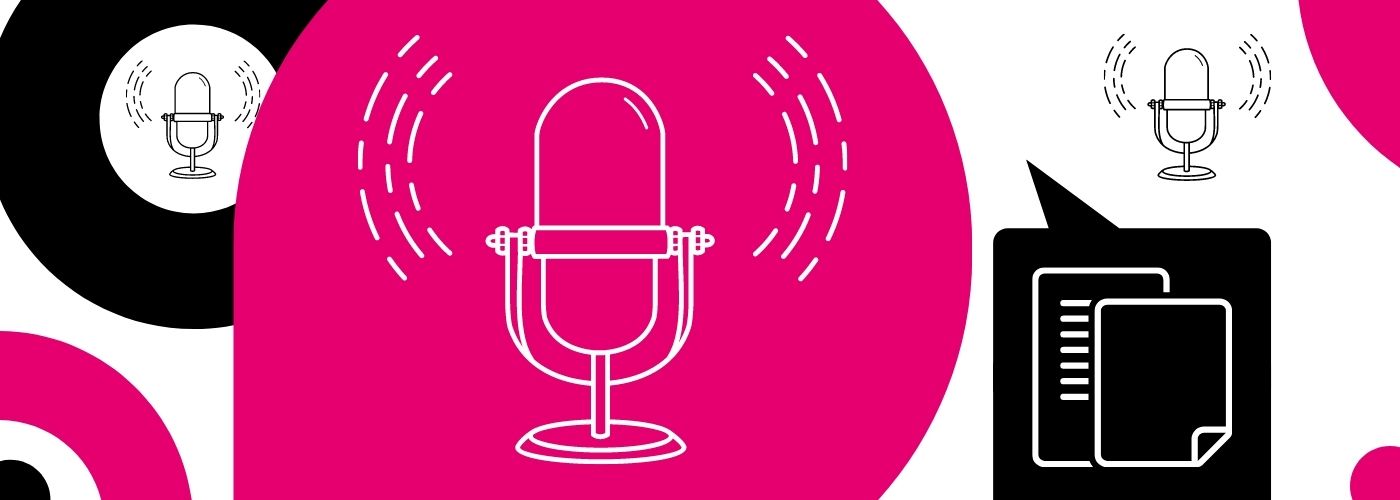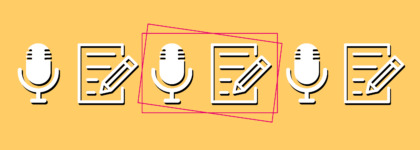5 Ways a Podcast Transcript Can Expand Your Reach
Updated: March 13, 2024
Tips for Creating an Accessible Podcast [Free Guide]
Podcast transcription is a major topic right now, and for good reason: Three leading podcast platforms were recently sued for not providing transcripts on their popular mobile applications.
While this lawsuit could have far-reaching legal consequences for the podcast industry, such as mandating transcription in a similar way to streaming companies providing closed captions, there are many reasons other than legal compliance for podcasters to provide transcripts.
In this blog post, we’ll go over five ways transcription can expand your podcast’s reach.
5 ways podcast transcripts can expand your reach
- Greater accessibility means you can reach a wider audience
- Boost SEO and find new listeners
- Repurpose podcast content for new audiences
- Get quoted and credited on other platforms
- Create a better UX with transcription
1. Greater accessibility means you can reach a wider audience
Podcasts are an incredible storytelling tool, but they’re an imperfect medium. Audio on its own is exclusionary to the approximately 48 million Americans who are d/Deaf or hard-of-hearing.
When you provide a podcast transcript, you increase accessibility and can reach a wider audience who would otherwise not have access to your podcast.
Additionally, audio-only content can create challenges for people who are not native English speakers and limit situational accessibility. What if your loyal subscribers can’t hear the latest episode of your podcast over the din of a noisy bus? Or they left their headphones at home and are stuck in a quiet waiting room? With a transcript, they could still access your podcast.
2. Boost your SEO and find new listeners
A search engine can index text far better than it can index audio. Search bots can’t listen to audio; they can crawl the metadata but not the content within the file.
A podcast transcript converts all the keyword-rich content from your podcast episodes into text that bots can read. You’ll find that publishing your podcast transcripts along with your audio files will significantly increase your web traffic, which will help you find new listeners.
How can we be sure?
This American Life tried it, and here’s what happened:
This American Life — Case Study
In 2014, This American Life decided to publish audio transcripts of their entire archive to learn how the transcripts impact SEO.
They discovered that:
- New inbound traffic increased by 4.36%, directly attributable to the new audio transcript pages.
- New inbound traffic via search increased by 6.68%, directly attributable to the new audio transcript pages.
- Inbound links increased by 3.89%, directly attributable to the new audio transcript pages.
- At least one transcript was viewed by 7.23% of all unique visitors.
If you rely on a YouTube channel to attract new listeners, you can upload the podcast transcript to YouTube and create closed captions on your podcast video. Closed captions are also proven to increase YouTube and video SEO.
The increased search rankings and extra search traffic will help new listeners discover you and help returning listeners find and share their favorite episodes more easily.
3. Repurpose podcast content for new audiences
After going through the trouble of producing a brilliant podcast episode, shouldn’t you make the most of it? Adding a podcast transcript can help you do just that!
From one podcast episode, you can make many other pieces of content. Podcasters often post video versions of podcasts on their YouTube channels or turn their episodes into blog posts by publishing the audio transcripts.
Text blogs are still an essential part of driving traffic to your website. Instead of having to come up with all-new written content for your blog, you can save yourself some time and use podcast transcripts for quotes, content ideation, and more.
Plus, some people prefer to read instead of listening to audio. Why not let those audiences enjoy your podcast in their preferred format?
Some ideas for repurposing podcast content include:
- Turning quotes into snippets for social media
- Generating blog content for podcast recaps and related topics
- Using transcripts in email newsletters and marketing campaigns
4. Get quoted and credited on other platforms
A podcast transcript increases your chances of getting quoted in a tweet, blog, or article, which improves page authority and SEO.
If you don’t have a transcript and someone hears something they want to quote on your podcast, they would have to transcribe the quote themselves to share the content. That’s often too much trouble for your listeners, and you risk being misquoted or not credited. However, if you provide a podcast transcript, listeners can copy and paste the quote they want to share with proper attribution.
Researchers or bloggers may stumble upon a particular episode of interest via Google search, and a handy audio transcript makes it easy for them to quote your podcast and, importantly, cite you as a source. With that come valuable inbound links to your site.
In short, providing a podcast transcript will make your episodes vastly more shareable, quotable, and citable, which can drive new audiences to your show.
5. Create a better UX
Podcasts are fantastic to listen to while exercising, driving, or doing other tasks on the go. However, since podcasts aren’t visually engaging, it’s more challenging to keep listeners engaged while they’re sitting in front of a computer screen. Additionally, some people prefer reading or skimming text to listening to audio.
With a transcript, someone can read along as they listen to the podcast. You can even take that to the next level by making the transcript interactive. Listeners can click on a word and jump to that point in the audio, scrolling through to a different section of the episode.
With repurposed content, you’ll also create a better UX for desktop audiences who may prefer to read a blog post or listen to a snippet of content on social media rather than a full audio-only episode.

This post was originally published in September 2016 by Emily Griffin and has been updated for freshness, accuracy, and comprehensiveness.





